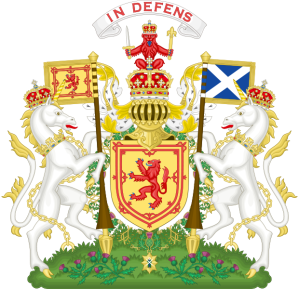Centuries ago, during the great age of chivalry, one of the must have items for any self-respecting knight was to have his own coat of arms. By the 1100’s feudal lords and their chivalric vassals were all using arms on the battlefield, principally as a means of being identifiable by your own soldiers and also so that you were able to identify the enemy. As time moved on however, these arms became more than just and identifier in battle and they became more widely used as a sign of family ownership or allegiance and the right to bear arms became hereditary.
In Scotland, as in England, the right to bear arms was granted to a single individual and those arms became his legal property which could be passed on to his son. The Royal Arms of Scotland have their origins in the reign of King William the Lion (r. 1165-1214). A register kept in the College of Arms in London describes the arms of the, “Kyng of Scottz,” as, “lion rampant within a double tressure flory counter-flory Gules.” This Lion Rampant design came to be used on the Great Seal of Scotland which the monarch used to authorise documents and enact laws.
The position of the motto in on armorial bearings in Scotland is unusual when compared to the practice in other heraldic systems. Instead of the motto scroll being shown below the shield as in most countries in Scotland it is shown above the crest and forms an integral part of the arms. The motto, “In my defens God me defend,” is now most commonly abbreviated to appear as just, “In defens”.
During the reign of King Charles II (r. 1649-1685) he had the motto of Scotland’s highest order of chivalry, the Most Ancient and Most Noble Order of the Thistle, included in the Royal Arms. That motto is, “Nemo me Impune Lacessit,” which means, nobody shall cross me with impunity.
The supporters of the Royal Arms are unicorns, facing towards the lance in order to show respect to the banners which they carry. One of the unicorns supports the lance with a saltire attached to it and the other supports the lance with the Royal Standard of Scotland (commonly referred to as the Lion Rampant), representing the monarchy.
The other interesting feature about the unicorns is that they have open crowns placed around their necks. The crowns are attached to chains which are wrapped around the animals bodies and are then anchored to the ground.
In the modern era these chains around the unicorns have been occasionally deliberately misrepresented by British nationalists as meaning that Scotland was forevermore chained to England and thereby would never regain independence. That would fail to explain why the unicorns were bound in chains on the royal arms prior to the Union of the Crowns in 1603, it is impossible that kings of Scotland would allow symbolism suggesting the superiority of a foreign power to be included on his own coat of arms.
The truth of the chains around the unicorns is far less politically reasons than that. Quite simply in mythology a free unicorn was considered to be an extremely dangerous beast, the chains represent these powerful animals have been tamed and the crowns around their necks represent that they belong to the king.
After the Union of the Crowns in 1603 the Royal Arms of Scotland and England were merged to form a coat of arms for Great Britain, even though that did not become a legal entity until the Act of Union in 1707. For over 400 years now there have been two versions of the British then UK arms in use, one for general use and one to be used specifically in Scotland. In the latter the Scottish Royal Standard is present in the 1st and 4th quadrants with the English Royal Standard in the 2nd and the Irish harp in the 3rd; whereas in the other version the English Royal Standard is represented in the 1st and 4th quadrants with the Scottish Royal Standard in the 2nd.
The currently used version of the Royal Coat of Arms of the United Kingdom for use in Scotland had not been altered since the accession of Queen Victoria to the throne in 1837. The banner (flag) from the coat of arms is used by the Queen when in Scotland, on her transport and flying above Holyrood Palace and Balmoral Castle when she is in residence.



I never understood why the unicorn was considered a wild beast to be chained while the lion has no chain and is crowned. It seems more like a motif to symobolise Scotland’s unicorn as being subordinate to the British Lion. It might be more a case of the unicorn representing freedom of spirit being subjugated by the aggresive predator of state.
It does not symbolise an inferiority to the English lion, when the kingdoms merged to form the union, one English lion and one Scottish unicorn was dropped so that each county has one of its supporters holding the new coat of arms, they are equal in heraldic status. The chain was there long before the union of the crowns, it merely represents that the king has the the power to tame wild beasts. In a literal sense he was warning his subjects not to mess with him.
Kinda suggests that we Scots are wild beasts………………
Sometimes we are, when appropriate.
A nice rewriting of history! The version of the royal standard since queen Victoria’s reign. Quite clearly redesigned to symbolise Scotland’s subjugation whatever the original symbolisation was.
What are you on about?
There was no Union of the Crowns in 1603, it is a misnomer. The monarch was shared but the countries involved remained sovereign states until 1707, separate kingdoms, separate crowns, just a common, shared monarch.
Why is the Arboath, Sotland, coat of arms identical with the Ludgate coat of arms?
Pingback: Chinook Dream – Part 7 – For Such A Time As This